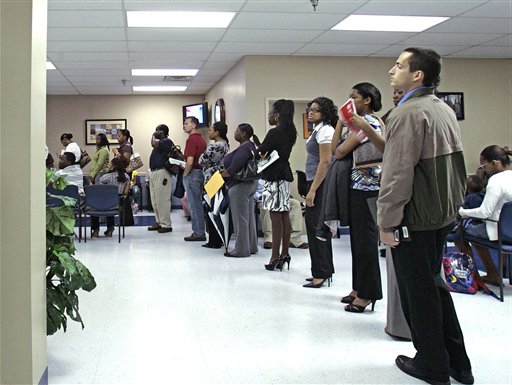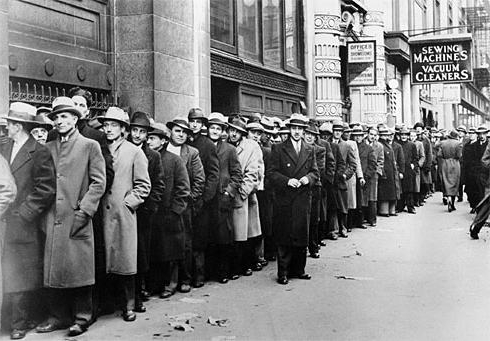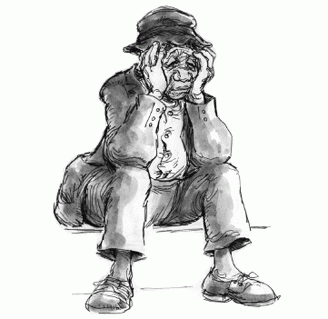Consider the types of unemployment and its essence. Also from this article you will learn what the concept of "full employment" means and how to determine its level.
Unemployment is a socio-economic phenomenon that occurs when part of the labor force (a population that is economically active) is not engaged in the production of services or goods. Along with the employed, the unemployed form the labor force of a country. Unemployment in real economic life appears as an excess of supply over demand for labor.
Who can be called unemployed?

Two statistical indicators are used today in Russia. Unemployed, according to ILO standards, include persons who have reached the age of 16 years and in the period under review:
- they had no job or gainful occupation;
- they were looking for work, that is, they contacted a commercial or state employment service, placed or used print ads, addressed directly to the employer (enterprise administration), used personal contacts and other methods to search for it, tried to organize their business;
- were ready to start work.
In order to classify a person as unemployed, compliance with all three of the above conditions is required.
The registered unemployed employment service includes people who do not have a job, seek it, and receive official unemployment status in the prescribed manner.
It should be noted that usually people who are unemployed are not only those who were laid off for various reasons, but also voluntarily left their former place of work and attempting to find a new job.
Unemployment structure

4 main categories of labor make up the unemployment structure:
- persons who have lost their jobs due to dismissal;
- leaving work voluntarily;
- come after a break to the labor market;
- newcomers to the labor market.
Primarily from phases of the business cycle the ratio of these categories depends.
The essence of unemployment

There are different concepts of unemployment, but on the whole, the prevailing point of view is that, at its core, unemployment reflects the economic need to use resources. In particular, this is evidenced by its natural level, which is defined as the existing level of unemployment at full employment. In this case, full employment does not at all mean one hundred percent employment and the absence of unemployment. It indicates the presence of frictional or structural unemployment, as well as the absence of its cyclical variety. We will tell you more about them below.
Structural unemployment
Considering the types of unemployment, it is necessary to talk about its structural variety. It is caused by a mismatch between the supply and demand structures of labor according to geographical, demographic, qualification and other criteria. This is a severe form of unemployment, since the costs are very high for eliminating it (for changing education, creating institutions for changing or improving qualifications, and for retraining people). Over time, the need for certain types of profession decreases, and some specialties disappear altogether. But there is a demand for new ones. This type of unemployment is quite painful. The fact is that technological progress constantly gives rise to new technologies, products and entire industries (for example, the production of fiber optics, laser disks and personal computers refers to them). As a result, the structure of demand in the labor market is changing dramatically.And people who turned out to be owners of professions no longer needed replenish the ranks of the unemployed.

Frictional unemployment
Frictional (or fluid) - unemployment, associated mainly with voluntary job changes, as well as seasonal fluctuations in demand on the labor market. Seasonal unemployment is thus an integral part of friction. The latter occurs when people lose their jobs, but will soon find a new one. Searching for the best job. This view is not a serious problem. Even in countries that are booming, there is frictional unemployment.
Its reason is that a worker dismissed from the enterprise or voluntarily left his job takes a certain amount of time to find a new job, which should satisfy him both in terms of pay and by occupation. Some people feel that they are able to perform more highly paid and difficult work, they are looking for it. And others are convinced that they do not meet the necessary requirements in the place they occupy, so they must find a job with lower pay.
Also, always on labor market there are unemployed people who are looking for the first time a job (women who have raised children, youth, etc.). They are also taken into account when determining the level of a given type of unemployment. In a well-organized economy, frictional unemployment is simply inevitable. The types and consequences of underemployment, however, are not limited to this. We turn to the consideration of cyclical unemployment.
Cyclical unemployment
It reflects the state in which the economic situation in a particular country is located, as well as the excess of labor supply over demand during a recession in the economy. In other words, it is caused by a decline in production. When aggregate demand for services or goods decreases, employment decreases and unemployment rises. In the USA, for example, during the Great Depression (in 1933), cyclical unemployment reached 25%.

There are other types of unemployment that are associated with different criteria for its classification: forced nature, duration, concentration in trade union groups, regions, industries or age categories. In particular, hidden unemployment stands out among them.
Hidden unemployment
If available, workers are only forced to be part-time, part-time, as there is no work. Otherwise, it is also called part-time employment. This type of unemployment affects owners of small enterprises, earning income below the average wage. These people are ready to leave the company at any time. Hidden unemployment is especially characteristic of rural areas. Formally, ruined peasants are considered independent owners, but in reality they are unemployed - in this type of production they are superfluous.

However, we have not yet listed all types of unemployment. There is, for example, seasonal (stagnant) unemployment. What is it?
Seasonal (stagnant) unemployment
Levels and types of unemployment are very diverse. Among the latter stands out seasonal unemployment. This is, first of all, the presence of people who work at home, and not in factories. Homeworkers are only fully employed during certain seasons. However, they are considered unemployed the rest of the time.
Voluntary unemployment
Considering the main types of unemployment, it should be highlighted and voluntary. This type of it is caused by the fact that in every society there is a stratum of people who, for mental reasons or for other reasons, do not want to work. It also occurs in cases where the dismissal of an employee occurs at his own request, for example, if he is dissatisfied with wages or working conditions.
So, we answered the question: "What is unemployment?" Types of unemployment, causes of unemployment were considered by us. Now let's say a few words about full employment.
Full time and its level
In most countries, full employment is understood as the absence of cyclical unemployment in the presence of structural and frictional unemployment, that is, when unemployment is in line with the natural norm.
The level of full employment can be determined by subtracting the unemployment rate, which is considered natural, from the labor force. The natural level for each country is determined in its own way, there is no single value. In the mid-1970s, for example, American economists believed that this rate for their country was about 4%. This level today has risen to about 5-6%, which is associated with institutional changes, as well as with a change in the demographic composition of workers.
Who is not taken into account when determining the size of the labor force?
When determining the number of labor, do not take into account people who are not employed in production and do not want to get a job. Representatives of this category can work, but for some reason they do not. These are pensioners, full-time students, housewives. Not included in economically active population prisoners serving sentences in prisons, as well as children under 16 years of age.
Military personnel represent a special category. They are included in the aggregate labor force, but are not taken into account when determining the labor force employed in the civilian sector.

So, we examined the concept and types of unemployment. Now you also know how to correctly calculate the full level of employment. As you can see, the types and types of unemployment are very diverse. The labor market has a complex structure. Any state strives to ensure that there are as few unemployed as possible, so that all people can work as efficiently as possible for the benefit of society. The nature and types of unemployment are an important topic. Knowing it is necessary for every economist.
